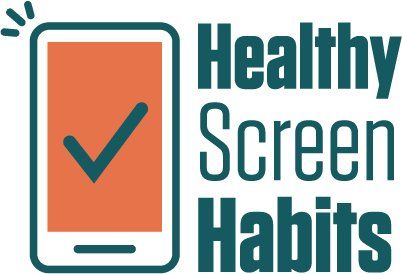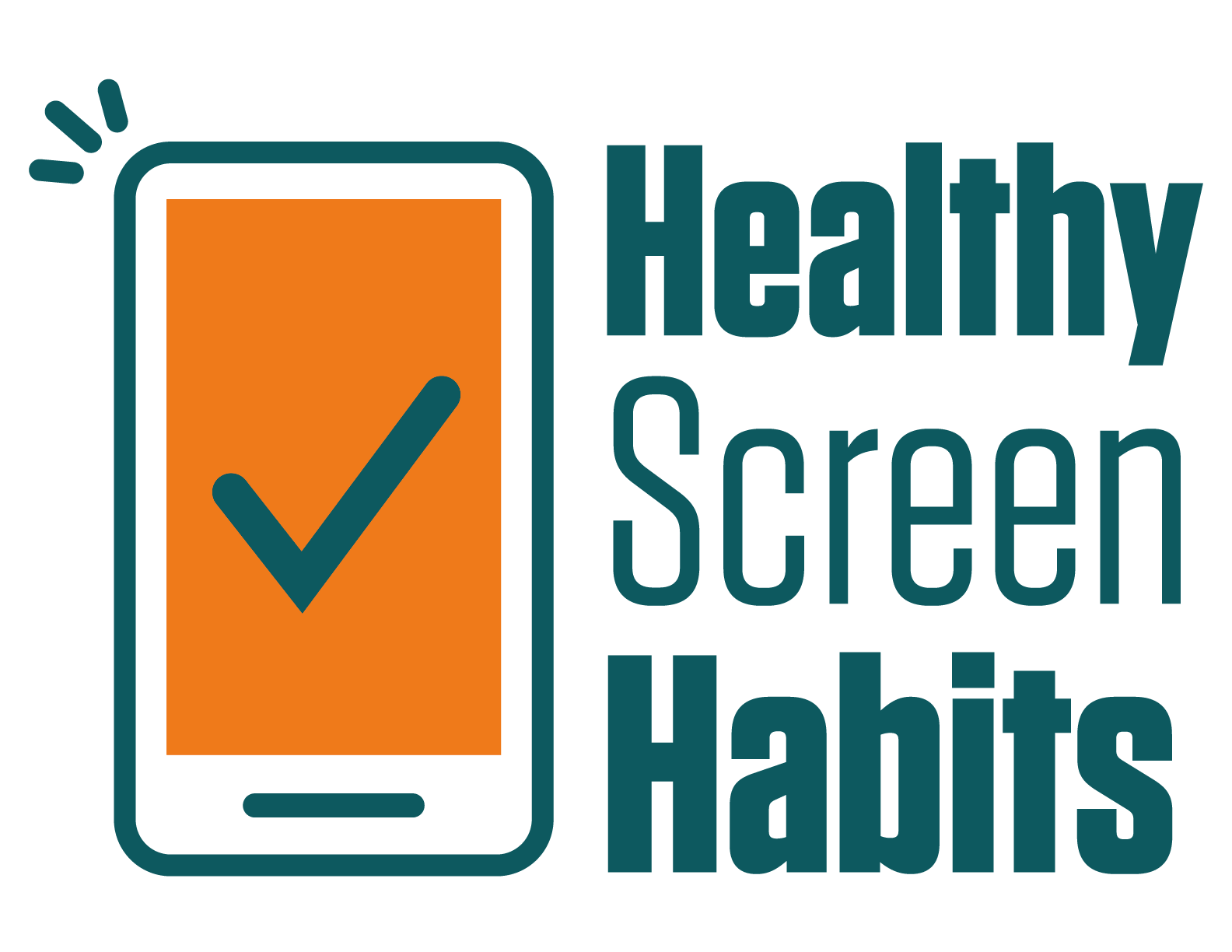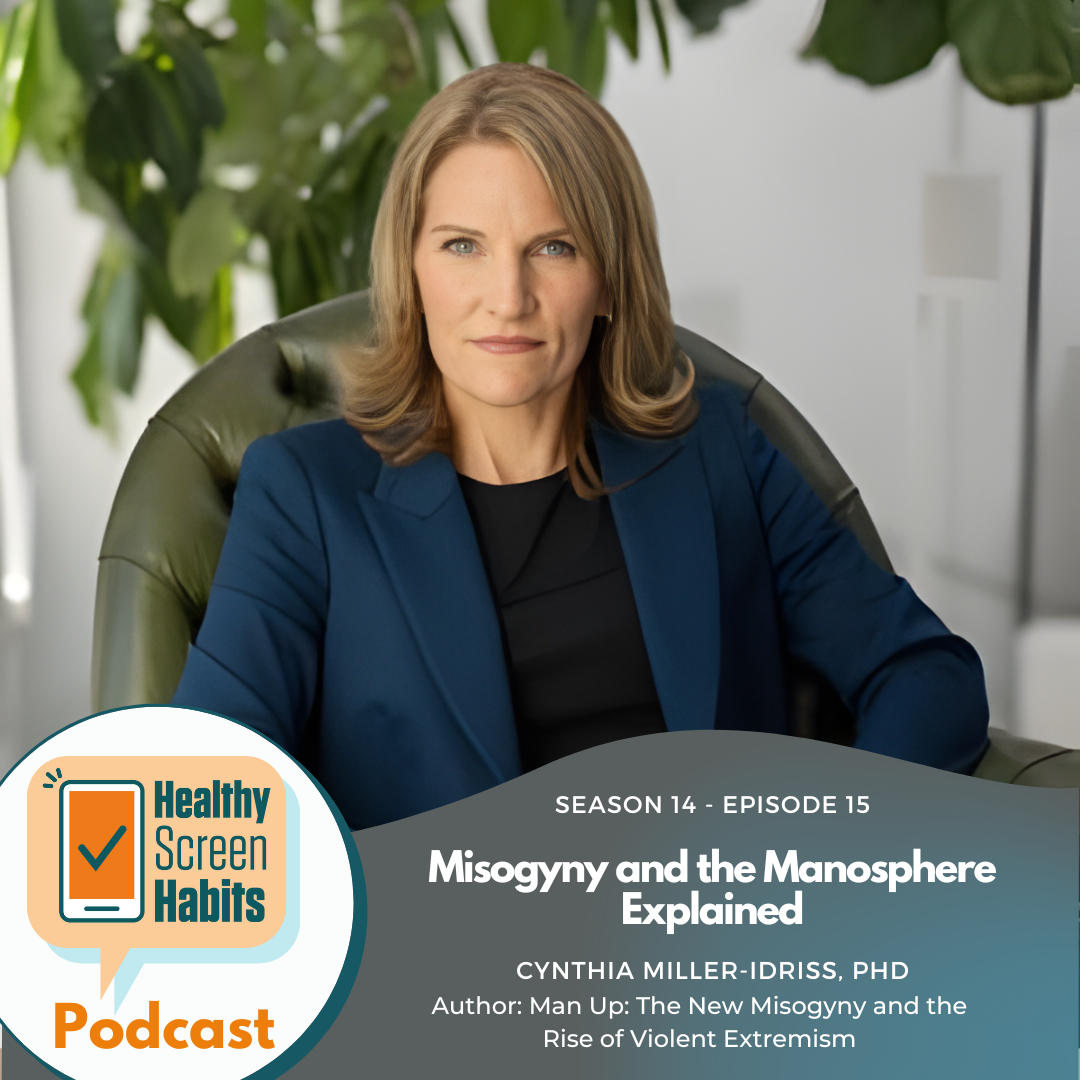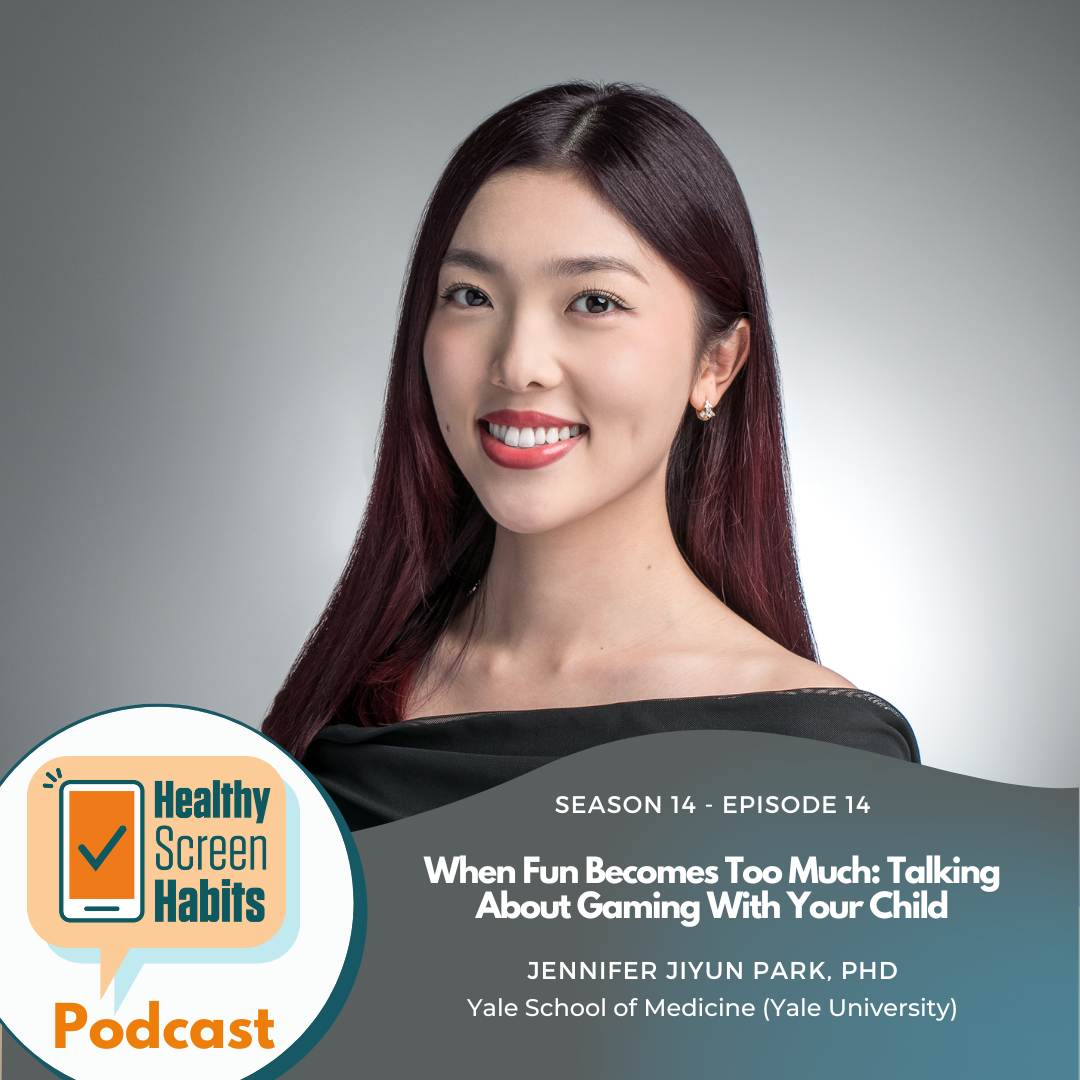S8 Episode 8: How Dopamine Rules The (Digital) World!! // Aniko Hill
Hosted by Hillary Wilkinson
"Social comparison is a normal part of adolescence, but what we're seeing on social media is ….. like a supercharged social comparison."
~Aniko Hill
Aniko Hill made a career of mastering marketing and social media. Fast forward to pandemic times when we all were living online and she recognized that the same techniques she used professionally were keeping her son hooked on tech. Aniko took a deep dive into the digital wellness pond and co-founded DopaMind, an upcoming non-profit whose mission is to educate kids about brain science and let them be their own heroes.
Listen now to learn about the science behind the “turn it off” meltdowns and more!
Healthy Screen Habits Takeaway
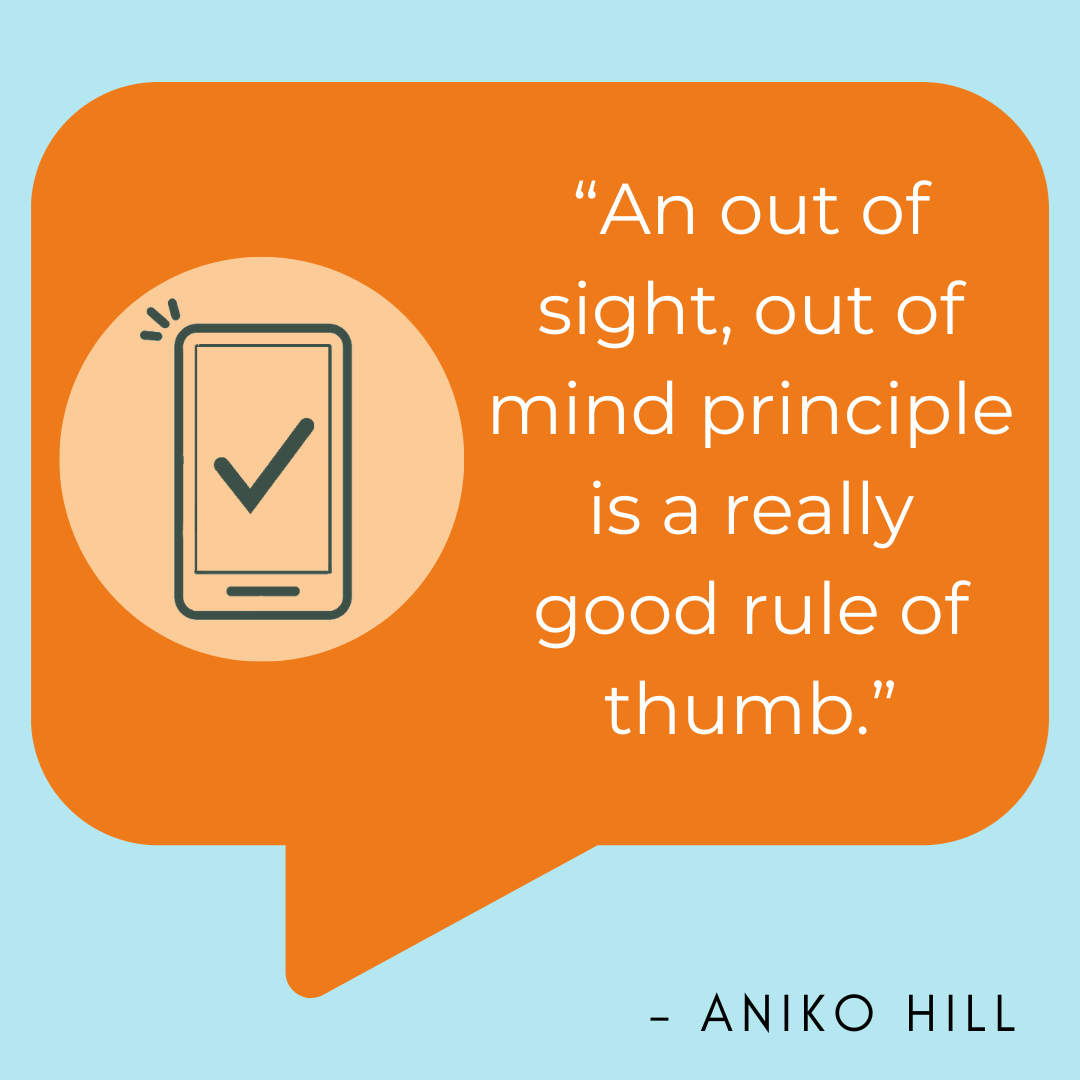
Resources
For more info: Dopamind's website
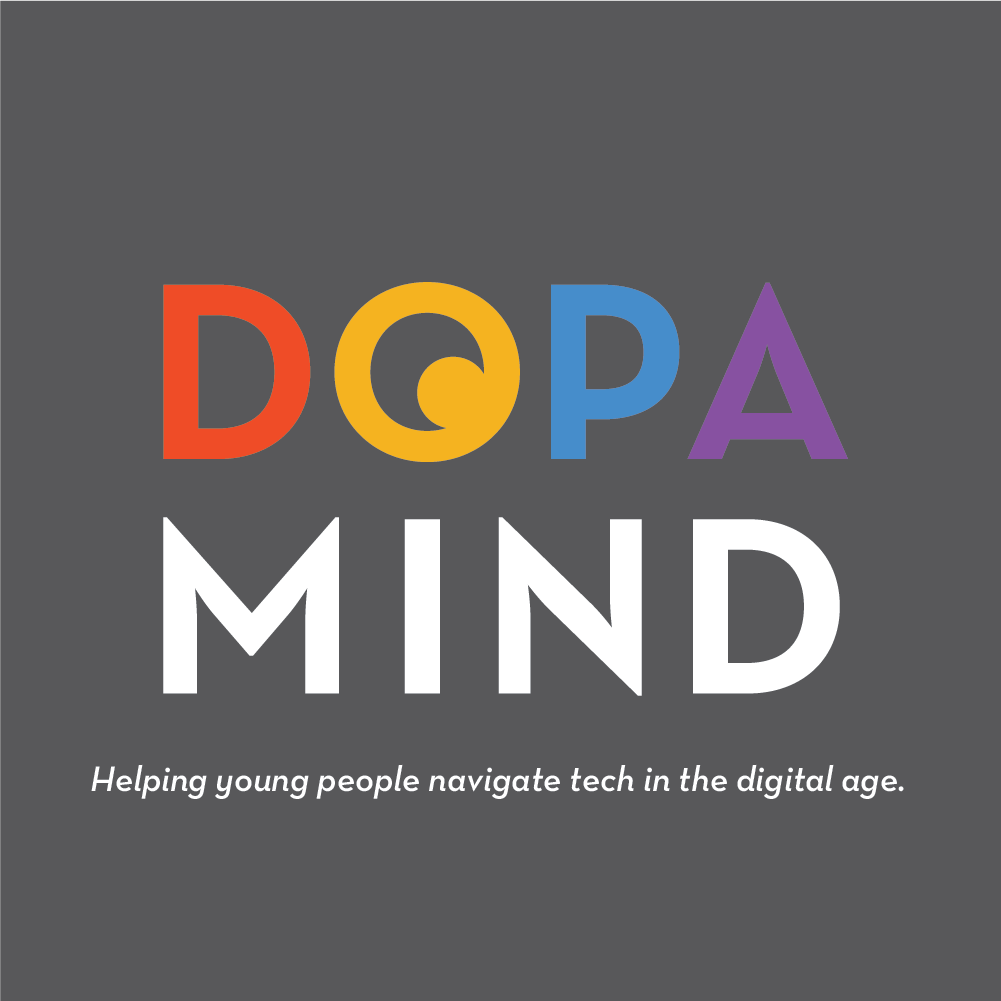
Show Transcript
Hillary Wilkinson: (00:00)
Fun fact, I was not a huge fan of the Wizard of Oz growing up. I thought the monkeys were creepy and the witch was scary. And it wasn't until I was much older that I kind of even actually understood the whole scene where they peeled back the curtain and reveal that the wizard is not this great and almighty oz, but just this regular dude. And that was the turning point for me when I got older. Actually, when do, when the story got good, that was when Dorothy realizes that she's the hero of her own story. She holds the key to her own happiness. And indeed, there's no place like home. And I bring all of this up because today I feel like we get to pull back the curtain a little bit on social media.
Hillary Wilkinson: (01:06)
And we're talking to somebody who is really giving every kid that opportunity to hold the key to their own happiness and make themselves their own heroes. She is a veteran social media marketing expert. She founded an award-winning creative brand agency called The Kitchen Collaborative, where they build premium brands in a wide range of industries. It has nothing to do with cooking, which really confused me, but . Um, I'm excited to get a peek behind the curtain on social media branding and her latest project. It is this exciting nonprofit called Dopamind, and this is where the magic's happening, this sort of synthesis of knowledge from social media marketing and educating today's youth on the behind the scenes, the behind the curtain. Welcome to Healthy Screen Habits, Aniko Hill.
Aniko Hill: (02:13)
Thank you so much,
Hillary Wilkinson: (02:15)
Anniko. When we talk about like many aspects of screens and habits over and over again, we hear the term dopamine mm-hmm. . And I'm just wondering, can you give us a dopamine 1 0 1 overview of what it is? What does it do? Why do we keep hearing about it in this niche?
Aniko Hill: (02:41)
Yes. And I will preface it by saying I am obviously not a neuroscientist. So the way I'm going to explain it is very similar to the way that we would explain it in our school programs to parents, teachers, and so that they can easily explain it to kids. So what it is, it is the most important chemical messenger in the brain. Now, if you don't know what that means, that's okay. Just know that it is responsible for sending feel good messages. So how do we get it? We get it from accomplishing, learning, or discovering something new. And that's where we get rewarded with dopamine. And that's what makes us want to repeat these feel good behaviors. And this is called the reward circuit in the brain. You might've heard that term before. And having the right amount of dopamine is really important for the brain and also for the body.
Aniko Hill: (03:29)
And so the way I like to think about this, and again, this is the way we explain it to kids. We call it the feelings teeter-totter. So it's called, in more complicated terms, the pleasure and pain principle. So pleasure and pain work like a balance in the brain. So just like a teeter-totter going up and down. The thing is, it wants to be level. And so for like the pleasure side, you know, we also like to explain what some of those feelings might be. So joy, excitement, things like that. The pain side is sadness, anxiety, pretty straightforward, but also boredom. And, you know, I could go off on, on boredom for a while. Um, it's something we need, but it's also painful, which is why as good meaning parents, we often try to relieve our, our kids of this. So think of the teeter-totter. So when you engage in any activity that gives you dopamine, and I wanna be clear, like everyday activities can give you dopamine as well.
Aniko Hill: (04:31)
But when it comes to tech, it's giving us lots of dopamine, kind of concentrated dopamine. So what happens is you tip very far onto the pleasure side of the principle, um, the ple pleasure pain principle, and that, that feels really good when it's happening. But the brain science says when there has to be basically a reaction to that. So it's going, the teeter totter is gonna tip back down to the pain side. The problem is that side is the reaction is stronger and longer. So it can often make us feel more anxious, more sad, or more mad at the end. And then, you know, as you can imagine, you will need more and more dopamine to feel good. And eventually what can happen is using the devices, using the tech can become the only thing that offers enough dopamine for you to feel good. And it's, I'm sure, you know, this is resonating with many parents.
Aniko Hill: (05:27)
It makes it hard for kids to want to do anything else. Everything else is, is harder. This is a much easier, more potent way of feeling good and getting dopamine. And then I just wanna add one more thing to this as a side note, because this is the way this works in my family. My, my son is naturally an anxious kid and he is the one that really drove this project for me on a personal level. There's many other reasons for it. Um, but he is a naturally anxious kid. So if you're naturally anxious, sad, or maybe you have a harder time with boredom. So just like my son, he likes to hit that dopamine hard mm-hmm. because it makes him feel calm and makes them feel happy. But the problem is we get a lot of dysregulation because it tips way back down the other way. Um, and so those kids are gonna be prone to more dopamine deficit or overload for those reasons because they're naturally seeking those rewards. So, um, so hopefully that gives you kind of a basic understanding of how it works in the brain.
Hillary Wilkinson: (06:36)
I think most parents can recognize also what you're talking about that I'm gonna, for lack of a better term, I'm just gonna call it that dopamine crash is the meltdown. Mm-hmm. that happens
Aniko Hill: (06:49)
Yes.
Hillary Wilkinson: (06:49)
You're pulling, you know, pull the iPad, pull the, um, you know, Cocomelon, whatever, you know? And it's, um, that's the, that's the crash. And that's why those feelings are so big
Aniko Hill: (07:01)
Mm-hmm. for
Hillary Wilkinson: (07:02)
Such a little body. Yeah. Yep.
Hillary Wilkinson: (07:05)
Yeah. And that tendency to use tech to try to regulate. 'cause we as humans try and try and live in this kind of homeostasis mm-hmm. . And we want, we want to bring us back to, we inherently wanna bring us back to that feel good state. So using that tech gets us caught in this loop of, we call it cycle of vulnerability, where you've got big feelings, don't know what to do with them. So you use tech to try and, you know, try and regulate, which then leads to more big feelings, which then, you know, you can just feel that, that that cycle happening.
Hillary Wilkinson: (08:56)
How does tech create a different type of dopamine hit than, say, like, offline life?
Aniko Hill: (09:10)
So it's not a different type of hit, it's really just that you're getting so much more of it than any other day-to-day activity. And one of the things that we talk about a lot is the basics of evolution of the human mind. And the reason this is so important is our brain is actually adapted for a time of scarcity. So think hunter-gatherer days like paleolithic era: food and water were, were hard to find. So our brain gave us rewards for when we ate, drank, socialized. These were all survival mechanisms, right? So this is the, the time that our brain is evolved in. So now we, now that we know about dopamine, uh, we're actually as a society able to design ways to get more of it. And this is not limited to tech. I mean, you can talk about the food industry and other industries as well, but since this conversation is limited to tech, we'll we'll stay in that lane.
Aniko Hill: (10:13)
But basically almost everything on a computer, a phone, a TV or a gaming system is designed to give us lots of dopamine and that's what's gonna keep us interested and on our screens longer. So it's really a volume thing and not is this a different type. Um, and then I think the one more thing I would underscore for this is, it's important to, to remember that you can get dopamine from day-to-day activities. But the thing with tech, even though it offers dopamine, it doesn't offer all the other feelgood chemicals that being in person offers. So some of those are, you might have heard of oxytocin, the love chemical, serotonin, which you get from satisfaction or importance, endorphins, which you get from exercise. So even though I, it's easier to get lots of dopamine very fast from tech, it's important to remember that you're not getting all these other amazing feel-good chemicals that you would get being in person.
Aniko Hill: (11:12)
And just a quick comparison. So, we'll, let's compare a few things. Um, in terms of dopamine elevation percentage, so chocolate, so again, going back to food, 'cause food elevates dopamine as well. You, you get a 50% elevation of dopamine from chocolate, um, video games a hundred percent. So double that, it happens to be the same as sex, cocaine, 350%, crystal meth is 1200%. And I, I know it feels a little weird to frame it in the context of drugs, but these are kind of common, uh, dopamine elevating, uh, items that, you know, where we could at least just get a, a sense of where we are in terms of orienting tech In this story.
Hillary Wilkinson: (12:03)
Yeah. No, and I don't think it's irrelevant to bring in other substances, because honestly it's the manipulation of your own chemistry that's happening, which also happens with other substances.
Hillary Wilkinson: (12:17)
I, I, I think it's a very valid comparison, Yeah. Um, yeah. So let's talk more about that. But first we gotta take a little break.
—--------------
Ad break : HSH Presentations
—---------------
I'm speaking with Aniko Hill, founder of Dopamind. A nonprofit organization working to teach kids and their caregivers, parents and teachers about how to navigate modern technology and empower them to make brain healthy media choices. She's also the founder of Kitchen Collaborative, which is a creative agency that does not deal with cooking, but rather the creation of successful brands. So Aniko I'm wondering, did your work with Kitchen Collaborative steer you towards creating Dopamind? I mean, how did you come to this digital wellness space?
Aniko Hill: (14:07)
So, yes, definitely in part, so Kitchen Collaborative, we founded it in 2005 and we actually started doing social media in 2007, which is essentially the dark age ages of social media. Um, my joke is like, when it's the dinosaurs roamed, like that's the way we need to think about that year. And if you think about it, um, the smartphone hadn't even come out yet. In 2007, we were doing corporate MySpace pages, but our philosophy at Kitchen Collaborative was always to be on the pulse and follow kind of where the, the business was going. And we saw that the business was gonna be going there and we adapted very quickly. So, um, but because I've been doing this so long, I've seen the full arc of the proliferation of modern screen technology, um, from what used to be a very kind of straightforward, chronological experience to the introduction of what everybody's heard the term algorithm, right?
Hillary Wilkinson: (15:12)
Mm-hmm.
Aniko Hill: (15:12)
Uh, when we started the ad buys were a mess. The ads didn't work, they weren't doing what they were supposed to be doing. So we started with that and came all the way to where we are today, right? And kind of followed what happened along the way. So I feel like I love the Wizard of Oz analogy 'cause I feel like we are definitely behind that, that curtain. 'cause we can see it from the marketer's point of view. Yeah, no,
Hillary Wilkinson: (15:42)
As, yeah.
Aniko Hill: (15:43)
Oh, I
Hillary Wilkinson: (15:43)
Was starting to say. Yeah. I think you are uniquely qualified to speak to this space specifically. So that,
Aniko Hill: (15:54)
That, that's what I keep hearing. 'cause at first I thought, wow, is this ironic I'm giving money to the social companies every month that I'm now sort of fighting against in a way, or pushing back on anyway. Um, but yeah, I do keep hearing that feedback that it, it, it is true because I do understand the psychology behind keeping p p people on their devices. I'm the one, not me personally, but my agency are one of the ones that, um, send you the creepy ads that follow you around, right? Like, we know how to do that and how to get you to buy something, right? Or do whatever it is that we want you to do. So that was definitely the start but really at the end of the day, I'm a mom and I struggled with managing what was diagnosed as tech addiction in my own house. And I wanna preface this by saying we were always a slow tech family. We were always that family, that limited tech. And you know, as you said earlier, we had a conversation about the pandemic, which I think we could spend a whole episode talking about.
Aniko Hill: (17:31)
This was wrapped up in that, you know, our institution said, yeah, it's fine. You know, be on your device all day and you know, you should probably get them their own device because they're gonna have to be on school all day. Um, and you know, also the entertainment is on there because, oh, by the way, you have to stay home and work as a mom, and you have to do Zoom school with your kids. Oh. And you have to be their caregiver. 'cause you can't have a nanny. So ours sort of, um, definitely developed on the tail end of that. I mean, we would send him to, towards the end there was these, uh, you know, different businesses that would offer like pods, right? Yeah. Where you could send your kid in, at least they were taken care of. And you could do Zoom school, you know, nobody knew they were letting him play Minecraft on the breaks, you know, so it was basically like an all day, um, dopamine overload.
Hillary Wilkinson: (20:11)
So we, we being healthy screen habits, recommend a graduated approach towards social media. We, um, with lots of conversation and pretty strong guardrails. And I was wondering, do you, at Dopamind, do you have ages and stages recommendations, particularly in the social media realm?
Aniko Hill: (20:38)
So with Dopamind, we are very careful about keeping our, staying in our lane in terms of educating parents on the brain science and sort of the basics and letting them go, make their own decisions. It's a very individual issue, um, not just on the individual level, but also on the family level. So what I'll give you is my, what I is going to be, I think, an unpopular professional opinion, which is very simple, and that it is not, social media is not for kids and teens at all. And the reason I say that is it was never designed.
Hillary Wilkinson: (21:15)
I'm happy to hear you say that. I'm happy to hear you put your social media professional hat on
Aniko Hill: (21:22)
And
Hillary Wilkinson: (21:23)
Recognize that. So, no, thank you for saying it. Sorry, I didn't mean to interrupt you. I'm
Aniko Hill: (21:27)
Saying no, I'm, I'm saying this as a social media marketer now, and not as a Dopamind educator. 'cause we wouldn't, we wouldn't get out of that lane. But I'll tell you why. Um, there's a couple reasons to, and they have to do with the way they were designed. So it was never designed with any cognitive or actual safeguards for the developing mind. So cognitive meaning, you know, as a, a kid, as a teen, you're basically, you have a preexisting condition, you know, in, in your brain. You're going in and, and interacting with these platforms that are very, very sophisticated in terms of manipulating human psychology, right? Um, but then there's the actual safeguards, right? I mean, this is
Hillary Wilkinson: (22:10)
What do you mean about the pre-existing condition?
Aniko Hill: (22:14)
I'm really talking about the fact that brain development is so rapid during this time. So, you know, a product that's designed to manipulate human psychology is hard enough for a grownup with a fully formed brain. I mean, the brain is developing until age 25. Some are even saying older. So the way we are looking at it, just, not just me, but our experts in the psychology field, is we're talking about people that don't have a fully formed, formed brain going up against these products that have thousands of engineers behind them that are, know how to manipulate human psychology
Hillary Wilkinson: (23:20)
And neuroscientists!
Aniko Hill: (23:21)
That's what I mean.
Neuroscientists, yeah. So that's what I mean by the preexisting condition. You're not going into it with a full, fully formed brain, you know, to really be able to navigate through this. And then there's actual safeguards, right? So then it's the things that most people know about, you know, the catfishing, misinformation, things like that, right? So there are no safeguards in place, um, for this
Hillary Wilkinson: (23:43)
Mm-hmm. .
Aniko Hill: (23:44)
Um, and then I would even go further and say it's, it's the same with smartphones and even iPads. Again, parents are not gonna be happy for me saying that. And what I mean is these are products designed for adults. There's no like kid iPhone, there's no kid iPad. It's the same device that you and I are getting. Now, I understand there are parent controls for content, but I'm really talking about the developmental side, right? The, uh, dopamine elevation being one of them. But just the way that, you know, when you design a product for a child, you're, you wanna take a take into consideration their cognitive, you know, abilities and developmental capabilities, things like that. And that's not the case with these products.
Aniko Hill: (24:37)
And then, you know, for me, again, just being in the industry so long, I'm just very tuned into what's going on just in Silicon Valley in general. Um, Steve Jobs, inventor of these products, iPhone, um, iPad, I mean, obviously had a team, but he spearheaded them. He famously didn't give his own kids iPads.
Hillary Wilkinson: (24:59)
Mm-hmm.
Aniko Hill: (24:59)
Uh, there's endless anecdotes about Silicon Valley execs that don't allow their kids on their own products I'm not saying don't do it. I mean, we, we do it as a family. I'm just saying it's important to remember that they weren't designed specifically for kids or teens. Um, and then, so let's, let's talk about social media specifically now in general. Cause people talk about the, I think you originally had asked like what age we, we recommend, so let's just talk about it in general. Um, so again, designed for adults, I will, you know, hit that ho home as much as I can. Um, but there is a 13 plus age recommendation. Okay? So the reason for this is pretty straightforward, and it has to do with the Children's Online Privacy Protection Act, which I believe goes all the way back to the nineties.
Hillary Wilkinson: (26:00)
Yeah. 1998.
Aniko Hill: (26:02)
Okay. And that simply prohibits companies from collecting personal information from children. That's it. So there's nothing about brain science, there's nothing about this is, you know, healthy for you, anything like that. That's what it's based on. Um, so there is a requirement, I put that in air quotes for users to be 13 plus. Um, but as I said already, there are no safety features for teens. However, 40% of kids age eight to 12 use social media already. So it's skewing younger. That statistic comes from Common Sense Media, uh, from their last report. Um, these us, US Surgeon General, I know you know about this, but he issued a major advisory, this is a big deal, uh, in May of this year actually. So he actually called for this to change in May, um, the, the age quote unquote limits mm-hmm. , uh, basically make it very hard or impossible for kids under 13 to be on at all and make it harder for, for teens having more parent consent and warnings, things like that.
Aniko Hill: (27:10)
So this is emerging and something that, you know, we're debating right now in society. But, um, it, it, it, for me, it really just goes back to that adolescence, right? Ages 10 to 19, they are going through a highly sensitive period of brain development. They're beginning to take more risks. They're, they have more emotional sensitivity and frequent tech use has been, um, shown to cause distinct changes in the developing brain. So I always kind of bring all this back to the brain science and the mental health, um, aside from all those other concerns, which are valid as well. Um, so kids this age are already more sensitive to social rewards and social punishments. So, and this is normal. Social comparison is a normal part of adolescence, but what we're seeing on social media is this, what we're calling like a supercharged social comparison. And then the last thing I'll say about that is we can also talk about social exclusion, which is huge. Um, so this is kids that because of your differences, and it can, it can be a lot of different types of differences are made to feel different to, or possibly less than the rest of the kids, right? So this is, I think, the reason why it is so hard for parents, because if every other kid is playing whatever video game, Fortnite, Roblox, whatever big, you know, video game is out there, or every other kid has a phone and you don't, it is painful not only for the child, but for the parent. Yeah.
Aniko Hill: (29:44)
And I felt it myself. We're a slow tech family. My son's 10, so he's starting to really, really feel this exclusion. And it's so hard as a parent to watch your child go through that. Yeah. Um, so, and again, this is normal. This is something that adolescents do, but tech just makes it so much more complicated and, uh, potent than it ever was before.
We need to normalize conversations with other parents about this issue because kids, you know, I I, I'd like to call it something better than lying. Let's call it wishful thinking. They often don't even tell the truth about what they have access to or what games they've played because they're trying to compete.
Hillary Wilkinson: (32:33)
Oh, absolutely.
Aniko Hill: (32:33)
Right? Yeah.
Hillary Wilkinson: (32:34)
So
Aniko Hill: (32:34)
I'll bust my son all the time where he says, oh, you know, so and so plays this, this game, and I'll talk to the mom and she'll be like, no, what are you talking about? You know, . And so this is why it is, like you said, just really important that we communicate. And by the way, we don't all have to agree. It's just we need to start normalizing having these conversations as mom with each moms with each other, and respecting our differences too, right? I'd love to be able to say, Hey, you know, when we, um, come over, like, just so you know, we really don't do social media, it's nice to have people around you that have the same ideas, but that's not gonna be the case, you know? So I think it's more about let's just communicate where we are. Mm-hmm. , uh, just like we would communicate, uh, you know, I'm a vegetarian, uh, when I come over, my friends might ask, Hey, do you have any dietary restrictions? “Yeah, we're vegetarian.” Big, you know, no big deal. Like, let's, let's accommodate for that. Right? So that's kind of the way that, that we'd like to see things going in terms of the way parents are talking about this. 'cause I, I do think it's something that we don't talk about enough.
Hillary Wilkinson: (34:06)
Yeah.very good point. So can you explain how different brands might try to elicit, say, different dopamine responses? Going back to the social media lanes, I guess I'm, I'm kind of trying to tap into your knowledge of marketing handholding with neuroscience, and is that something that can be specifically engineered?
Aniko Hill: (34:32)
Yeah, so it's not really the brands themselves that are manipulating human psychology. I mean, what we try to do really is, you know, to create kind of an emotional connection to our audience, right? Mm-hmm. mm-hmm.
Aniko Hill: (34:45)
You know, get them interested in buying whatever we're trying to sell. But I think it's more about what social media does, because as marketers, we are just, we're creating ad content or, you know, organic content as well. Um, and then we're plugging it into these, these systems. And I'll be completely frank, I mean, we, we definitely obviously know what we're doing in terms of what content's gonna do well, what messaging's gonna do well, things like that. But once you plug it in and you put in your parameters of who you want to target and how, and everything else, it's really the AI, the algorithm that is doing the rest. It is very, very good at meeting your objectives. So you set the objectives, but the algorithm does the, the rest. So just to back up for a second, um, the reason social media is, is inherently addictive.
Aniko Hill: (35:38)
Um, and I'm not saying you're going to get addicted to it, but that it can be addictive is because the engineers design the platforms to feed you dopamine to keep your attention longer. And the reason we want more attention is so that we can show you more ads, right? So, um, I'm sure you know who Tristan Harris is, founder of Center for Humane Technology, and he's one of the pioneers in speaking out, uh, he was a former Google engineer. Um, so I'm gonna paraphrase him and probably get it wrong, but he says something like, if you're not buying the product, you are the product, right? So social media is quote unquote free, but the reason it is free is because you're gonna be buying things off of your ads, and the advertisers are funding social media. So if we can keep that very simple principle in the back of our, our heads, that is just all you need to know is we want you on there longer. So it's so funny 'cause AI is such a huge buzzword now. Sure. Right? Everybody's talking about it. Everyone's worried about it. Well, we've actually had AI appointed at society for about 11 or 12 years now, and that was when the algorithm was introduced and when things really turned around for social media, it's about the time Facebook went public. Um, and what it does is it curates your feed to keep you engaged longer. So it's, it's curating for engagement and not chronological, which is what it used to be. So things are out of order, things are all over the place. You could refresh and get like a totally different, uh, feed, right? So that is the curation AI. Um, so it's optimizing and engagement is likes, comments, shares, views, all of those things can be engagement. Um, so that means like the stickiest content is gonna rise to the top and so I think that's the simplest way I can explain it. It gets more complicated than that. But I'll also again bring it back to the smartphone texting can also deliver ongoing dopamine rewards. Maybe it's not as hypercharged, right? Because it's not you against a thousand engineers on the other side of an AI. Um, but there, the, the built-in features of, of smartphones also feed dopamine. Um, and basically like what this all comes down to is the, you know, addictive tech can harm our mental health because it causes our dopamine levels to be out of balance I can't imagine what it would be like as a child to have to navigate or a teenager to have to navigate this. It, it would be impossible.
Hillary Wilkinson: (42:11)
On every episode of the Healthy Screen Habits podcast, I ask each guest for a healthy screen habit, which is a tip or takeaway that our listeners can put into practice in their own home. Aniko, do you have one?
Aniko Hill: (42:45)
I do, so we talked a lot about dopamine. So, uh, the brain can actually predict when a dopamine spike is imminent based on signs from the environment. And this pre-spike, it can actually be more strong than activity itself. So anticipating when I'm gonna play my video game, anticipating when I'm gonna watch my show. So a really simple way to sort of fight this a little bit is an out of sight out mind principle is a really good rule of thumb. So, and this is good for kids and adults. So for kids, like, it's as simple as just put the iPad away when it's not in use. Put the TV remote away. If you can create spaces, uh, in your house, like your playroom where you don't have these things. Um, and when you're not actively using them. So it can just make a big difference in keeping those dopamine levels, uh, in balance and in check and keeping. Um, none of us want the meltdowns, so it's a good way to avoid the meltdowns. Yeah.
Hillary Wilkinson: (43:58)
It's like putting the, the cookies on the top shelf
Aniko Hill: (44:02)
Exactly. Same thing.
Hillary Wilkinson: (44:04)
Yeah. Okay. As always, you can find a complete transcript of this show and a link to any of the resources discussed by visiting the show notes for this episode. Do this by going to healthy screen habits.org. Click on the podcast button and scroll to find this episode. Aniko, thank you so much for coming today to speak with me and to teach every kid that they can be their own hero. There is no place like home and we're all worthy of our own yellow brick road.
Aniko Hill: (44:38)
Thank you so much. It was great talking to you.
About the podcast host, Hillary Wilkinson
Hillary found the need to take a big look at technology when her children began asking for their own devices. Quickly overwhelmed, she found that the hard and fast rules in other areas of life became difficult to uphold in the digital world. As a teacher and a mom of 2 teens, Hillary believes the key to healthy screen habits lies in empowering our kids through education and awareness.
Parenting is hard. Technology can make it tricky. Hillary uses this podcast to help bring these areas together to help all families create healthy screen habits.
